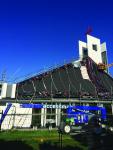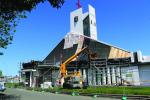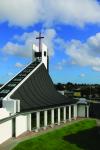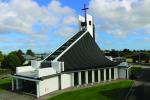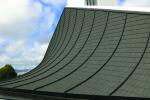Our Lady of Victories Catholic Church
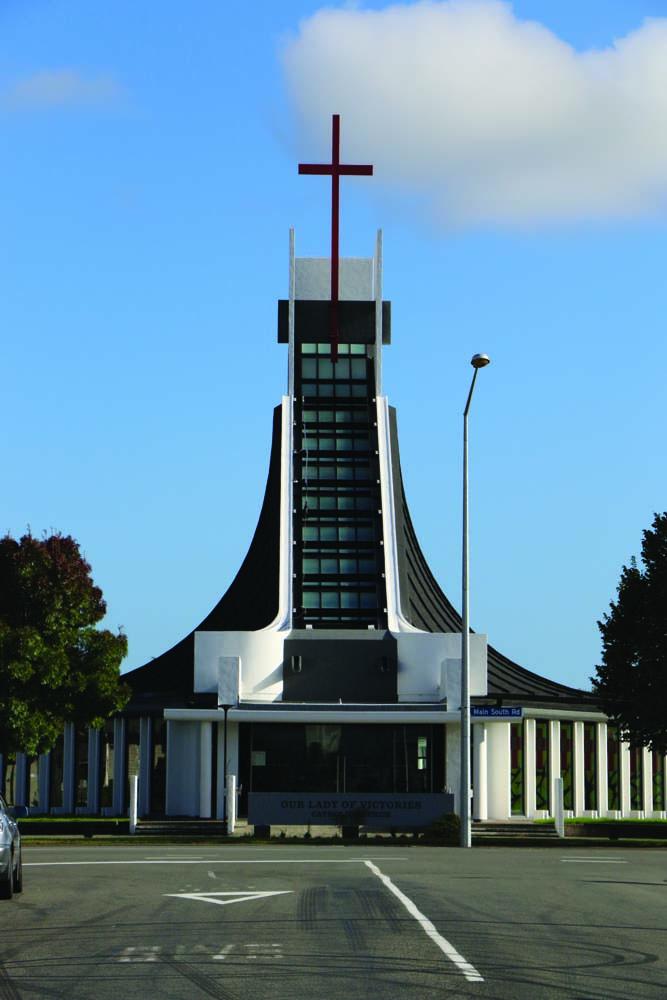
For architect Charles Thomas, designing the Our Lady of Victories Catholic Church was a dream commission.
He had started up his own practice in 1960 and then in 1965 he was approached by a member of the parish who said they wanted to build a church to replace the old one in the Christchurch suburb of Sockburn. Charles said he was told that the church had 36,000 pounds to spend on the new building, which was to accommodate a congregation of 400.
“I sat down and worked out something for 36,000 pounds that would accommodate 400 people and for that sort of money it had to be a simple structure, a rectangular building,” he said. “In those days I would also build a model of a building so when I finished that, they said, ‘Let’s go see the bishop’.
When he showed Bishop Brian Ashby the model, he said, ‘Mr Thomas, if you had a free hand to design the building, what would you do?’
“I said I wouldn’t have a rectangular space; instead I would have people sitting around the altar and the sanctuary, which would mean a diamond shape.
“I sketched it out for him on the back of the drawing that I had taken down to show him, and he liked it that much that he told me to go ahead with it.”
From there, Charles developed plans for the church with the belief that the design of a building should reflect the purpose for which it was built.
The plan of the church developed from the principle that the congregation should group around the sanctuary to hear the priest as they would if Jesus was speaking in his place. All the seating is arranged so that the entire congregation has eye contact with the Priest and feel as if he is speaking to each and every one of them as an individual, but also to create a feeling of community.
A curved roof was designed to appear as if God’s hands were reaching out into the community and bringing his hands together around his believers to bring them in communion while leaving his hands slightly apart to let in his light and love.
To create that effect, a hyperbolic paraboloid roof construction was used and was formed by using three layers of cross-laid timber.
“That was just one of the symbols that I used in the building,” says Charles. “The four supporting structural walls represent the four evangelists Matthew, Mark, Luke and John.
Where the “hands” are separated, a series of skylights allow light into the church and ascend like stairs to the cross, contained in a spire of three walls representing the Holy Trinity.
Charles said Bishop Ashby was so enthusiastic about the architectural vision that he allowed tenders to be called for the building straight away.
“All the elements in the drawings were realised in the building,” said Charles.
The building won the New Zealand Institute of Architects (NZIA) Canterbury branch design award in 1968, then the NZIA national award for excellence of design in 1970. In 2004 it won the NZIA branch enduring architecture award, and in 2005 the NZIA national enduring architecture award.
The church’s spire also appeared on a 1970 postage stamp.
Last year, when the church underwent refurbishment and seismic strengthening, the original metal roof tiles were replaced with similar profile and colour metal roof tiles to retain the integrity of the design.
Naturally, Thomas Associates Architects were brought in to consult on the job, and Charles was pleased to be involved again with one of his favourite projects.
Kevin Crawford, of Canterbury Roofing, said the 650sq m of roof area was replaced in stages with the job managed by Farrell Construction, and the roofers being Alan Faust and his son Noah.
He said, “As both the existing roof and the underlay contained asbestos, this was removed by specialist crews. We had to maintain a separation between the removal areas and the newly installed areas. “The job had 16 bays on each side of the building and so we were able to work on different areas to the removal crews. The job was done using knuckle booms, with four booms on site at once. We used hand rails around the perimeter of the building as our edge protection.”
Kevin said while no repair work was required to the roof structure, the lower part of the roof was well below minimum pitch, and actually fell backwards at the lowest point.
“The battens were packed and planed by Alan Faust to create fall. Butynol was then installed over cavity battens underneath the roof to allow a drainage path for any water that may leak through the tiles on the lower pitched section.”
To maintain the original look, Metrotile’s CF SHAKE in ‘Charcoal Blend’ was used as the roof replacement.
Kevin said this roofing material was chosen because of its robustness and clean look.
“The roof, once on, is not able to be easily accessed for maintenance or repairs so needs to be tough. And the roof tile chosen uses concealed fixings. This means no external fixings, producing a better-looking finish and no penetrations through the tile. “The tile is also installed from the bottom up, which sped up the process. We could work up the roof installing tiles and the ridge caps as we went. This was a big advantage as the curvature of the roof meant manoeuvring the boom lift was very difficult so this reduced the amount of time we had to get access to an area.”
Kevin said there were several other challenges to deal with on this job.
“The biggest factors were ensuring weather tightness during the job, and working in conjunction with the asbestos removal crew to ensure no cross-contamination or exposure. Air monitoring equipment was in place to ensure this.” He said that because metal tiles are generally used on residential type dwellings, the roofers were not experienced using the access equipment required to do the job, especially having to manoeuvre in so close.
“Because of this, we had experienced operators driving for Alan and Noah. The guys worked every day they could, only stopping while church services were in progress or if the weather was bad. Some days they were not finishing until very late at night.” Because the church is an award-winning piece of architecture, a lot of thought had to be given to flashing details to keep the original look while ensuring its weather tightness and making it vermin-proof.
Charles said the original roof had ribs to create gutters to direct water off its face, which slopes sideways as well as down. They had a practical as well as an aesthetic purpose and he was glad they were retained. “We were very pleased with how the new roof went,” he said. “Any building that we do we talk directly to the people who supply and install the materials because we are always focused on using the best materials along with the best workmanship, which is what we got here.”

